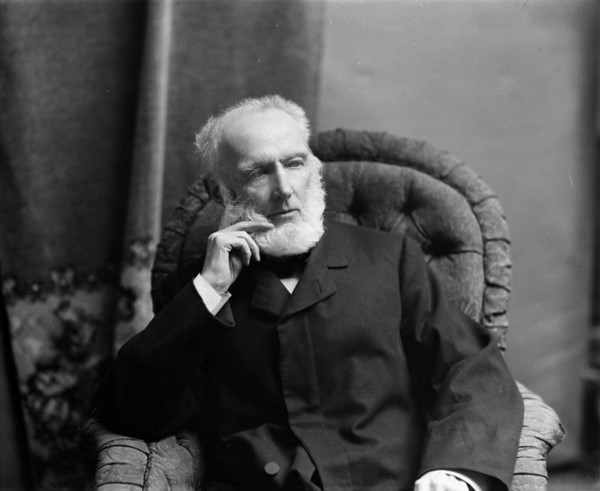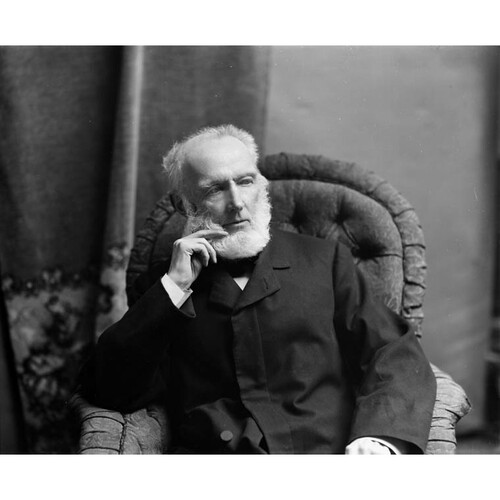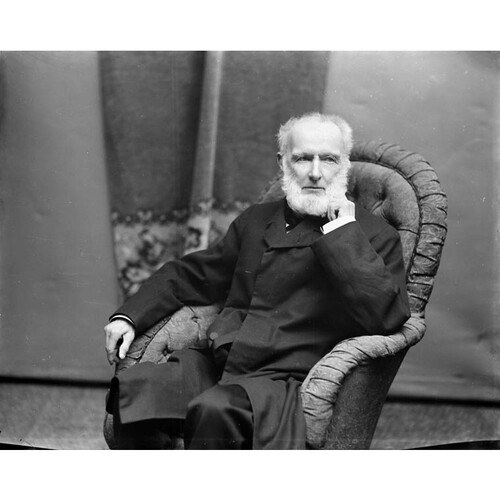LEWIN, JAMES DAVIES, office holder, businessman, and politician; b. 1 April 1812 in Womaston, Wales, son of Samuel Lewin and Mary Furmage; m. 17 Dec. 1831 Sarah Ann Clarke in Chatham, N.B., and they had at least seven children; d. 11 March 1900 in Lancaster (Saint John West), N.B.
James Davies Lewin was descended from private gentlemen in Wales; his mother’s family, of Middlesex, England, had been represented for generations in the British army and navy. After being educated at a grammar school in England, Lewin entered the British government service in 1830 and was assigned to the customs department on the Miramichi River, N.B. In 1838 he was promoted to the surveyorship at Saint John, and eight years later he was promoted surveyor at St Andrews, an important border customs station. The British customs establishment in New Brunswick was discontinued in 1848, and Lewin moved to Newfoundland as surveyor at St John’s. The next year the customs department there was abolished and Lewin found himself in search of a position.
Since his arrival in British North America, Lewin had been building a base in New Brunswick. While stationed on the Miramichi he had married the daughter of Richard Samuel Clarke, high sheriff of Northumberland County. During his posting at Saint John he had acquired considerable property. His decision to return to Saint John upon the dissolution of the customs department in Newfoundland thus appears to have been almost predictable. Once there Lewin engaged in the insurance business. He also obtained a lease from the city for approximately 200 acres in Lancaster Parish, west of Saint John.
Lewin had been a shareholder in the Bank of New Brunswick for several years when in December 1857 he was elected president and manager following the resignation of Thomas Edward Millidge. For more than 40 years, the bank was to be synonymous with Lewin. He retired as manager in the late 1880s but retained the presidency until his death. He was viewed favourably as a careful and somewhat conservative investor. However, his lengthy tenure as manager may be attributed as much to the emigration of talented prospective successors as to the laudatory assessments he received.
Lewin’s commercial interests connected him with some of the principal ventures attracting the business community of his day. He was a director of the Joggins Coal Mines Association and in 1853 he became a member of the first board of directors of the Saint John Suspension Bridge Company. Located near the outskirts of the city, this bridge linked the communities on both sides of the mouth of the Saint John River. In 1855 Lewin became president of the company, a position he held until 1875, when the bridge was taken over by the provincial government. Throughout the 1860s and 1870s he was instrumental in having the provincial government expand the approaches to the bridge from its west side.
During the 1860s Lewin, a free trader, actively fought against confederation, arguing that Maritime union and a reciprocity treaty with the United States “would be far more preferable.” He again took an active interest in politics following the Pacific Scandal of 1873 [see Sir John A. Macdonald]. With other Liberals, he worked to defeat the Macdonald government and welcomed the victory of Alexander Mackenzie in 1874. Two years later Lewin filled the Senate vacancy created by the death of John Robertson*. In the Senate his “quiet and retiring disposition” may have precluded his engaging in debates, but his financial skills were utilized on the banking and commerce committee.
Lewin’s last years were spent in his commodious home at Lancaster, where his daughter-in-law and grandchildren also resided. At his death a Roman Catholic newspaper observed that he had acquired the esteem of his community as a man “of sound judgement and of unblemished character,” the former perhaps illustrated by his estate of $320,000, and the latter demonstrated by the generous provisions in his will for his children and grandchildren and for the Methodist Church.
N.B. Museum, Saint John, real estate schedule, cb doc. PANB, RG.7, RS71, 1900, J. D. Lewin. Daily Telegraph (Saint John, N.B.), 12, 14 March 1900. Freeman (Saint John), 17 March 1900. Saint John Globe, 12 March 1900. DCB, vol.10 (biog. of John Robertson). N.B. vital statistics, 1857–59 (Johnson). E. W. McGahan, The port of Saint John . . . (1v. to date, Saint John, 1982– ), 21–35. W. S. MacNutt, The Atlantic provinces: the emergence of colonial society, 1712–1857 (Toronto, 1965). William Murdoch, “The Saint John suspension bridge,” New Brunswick Hist. Soc.. Coll. (Saint John), 4 (1919–28), no.10: 123.
Cite This Article
Elizabeth W. McGahan, “LEWIN, JAMES DAVIES,” in Dictionary of Canadian Biography, vol. 12, University of Toronto/Université Laval, 2003–, accessed December 28, 2025, https://www.biographi.ca/en/bio/lewin_james_davies_12E.html.
The citation above shows the format for footnotes and endnotes according to the Chicago manual of style (16th edition). Information to be used in other citation formats:
| Permalink: | https://www.biographi.ca/en/bio/lewin_james_davies_12E.html |
| Author of Article: | Elizabeth W. McGahan |
| Title of Article: | LEWIN, JAMES DAVIES |
| Publication Name: | Dictionary of Canadian Biography, vol. 12 |
| Publisher: | University of Toronto/Université Laval |
| Year of publication: | 1990 |
| Year of revision: | 1990 |
| Access Date: | December 28, 2025 |






